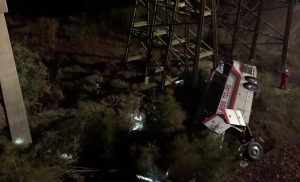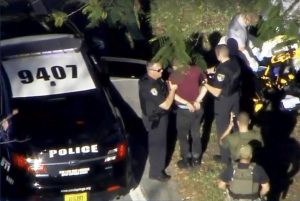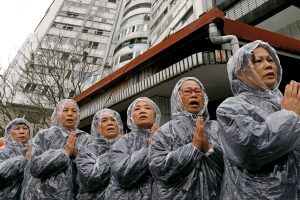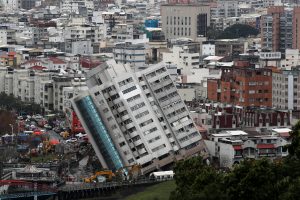
By Zachary Fagenson
MIAMI (Reuters) – Rescue workers combed through the rubble of a pedestrian bridge that collapsed onto several lanes of traffic at Florida International University in Miami, but hopes of finding more survivors were fading early on Friday, police said.
Six people were confirmed dead after the newly built 950-ton bridge crushed vehicles on one of the busiest roads in South Florida on Thursday. With at least eight vehicles buried and out of reach beneath the rubble, the death toll could rise, Juan Perez, the Miami-Dade Police Department director, said on Friday.
“There must be some others in the vehicles,” Perez told Miami’s NewsRadio 610 WIOD. “We know there’s bodies down there and we can’t get to them. It’s terrible.”
Emergency personnel with sniffer dogs searched for signs of life overnight.
At least 10 people were taken to hospitals and two remained in critical condition, officials and local media reported.
Witnesses told local media the vehicles were stopped at a traffic light when the bridge collapsed on top of them at around 1:30 p.m. ET (1730 GMT).
At one point, police urged television helicopters to leave the area so that rescuers could hear any cries for help from those trapped beneath the collapsed structure, CBS Miami television said.
Uncertainty over the stability of remaining sections of the bridge hampered rescue efforts, officials said.

Aerial view shows a pedestrian bridge collapsed at Florida International University in Miami, Florida, U.S., March 15, 2018. REUTERS/Joe Skipper
INSTALLED ON SATURDAY
The 174-feet (53-meter) long bridge connects the university with the city of Sweetwater and was installed on Saturday in six hours over the eight-lane highway, according to a report posted on the university’s website.
“If anybody has done anything wrong, we will hold them accountable,” Florida Governor Rick Scott said at a news briefing late Thursday.
His office earlier issued a statement saying a company contracted to inspect the bridge was not pre-qualified by the state.
The bridge was intended to provide a walkway over the busy street where an 18-year-old female FIU student from San Diego was killed as she attempted to cross it in August, according to local media reports.
Students at FIU are currently on their spring break vacation, which runs from March 12 to March 17.
To keep the inevitable disruption of traffic associated with bridge construction to a minimum, the 174-foot portion of the bridge was built adjacent to Southwest 8th Street, using a method called Accelerated Bridge Construction. It was driven into its perpendicular position across the road by a rig in only six hours on Saturday, according to a statement released by the university.
The $14.2 million bridge was designed to withstand a Category 5 hurricane, the most dangerous measure by the National Hurricane Center, and built to last 100 years, the university said. (http://bit.ly/2tQ2ARg)
Officials with the National Transportation Safety Board were on the scene early on Friday to investigate why it collapsed.
(Additional reporting by Gina Cherelus, Joseph Ax, Daniel Wallis, Jonathan Allen and Andrew Hay in New York, Scott Malone in Boston, Bernie Woodall in Fort Lauderdale, James Oliphant in Washington, Keith Coffman in Colorado and Dan Whitcomb in Los Angeles and Rich McKay in Atlanta; Writing by Jon Herskovitz; Editing by Andrew Heavens and Bernadette Baum)













